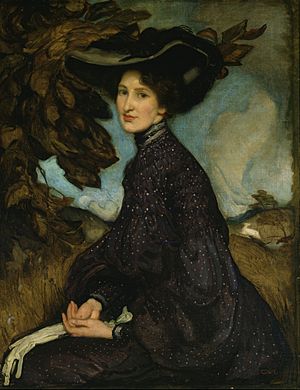Thea Proctor facts for kids
Quick facts for kids
Thea Proctor
|
|
|---|---|

Portrait of Proctor, painted by George Washington Lambert, 1903, Art Gallery of New South Wales
|
|
| Born |
Alethea Mary Proctor
2 October 1879 |
| Died | 29 July 1966 (aged 86) Potts Point, New South Wales, Australia
|
| Nationality | Australian |
| Education |
|
| Known for | Painting |
Alethea Mary Proctor (born October 2, 1879 – died July 29, 1966) was an Australian artist. She was a talented painter, printmaker, designer, and teacher. Thea, as she was known, was famous for her strong sense of 'taste' and 'style' in her art and life.
Contents
Thea Proctor's Artistic Journey
Thea Proctor was born in Armidale, New South Wales. Her father, William Consett Proctor, was a lawyer and a politician. Her mother was Kathleen Jane Louisa Proctor. When her parents separated in 1892, Thea and her mother moved to Bowral. They lived with her grandmother, who greatly encouraged Thea's love for painting.
Learning to Be an Artist
Thea began her art studies in 1896 at the Sydney Art School. She learned from a well-known artist named Julian Ashton. Later, in 1903, she moved to London to study at the St John's Wood School of Art.
While in London, Thea became lifelong friends with another artist, George Lambert. She often posed for him as a model. Thea lived and worked in London from 1903 to 1921, except for two years (1912-1914) when she was in Sydney. She spent time with other Australian artists living abroad, like Charles Conder, Arthur Streeton, and Tom Roberts.
Her Unique Style
Thea created beautiful pencil drawings and decorative watercolours. She also designed fans. Her work was inspired by Conder and by Japanese woodblock prints, which are a type of art made from carved wood.
She showed her art at important places like the Royal Academy of Arts in London. Later, she made lithographs (a type of printmaking) that were shown at the Senefelder Club and the London Goupil Gallery.
In 1911, Thea saw a performance by the Ballets Russes, a famous dance company. She found it "beautiful and inspired." This experience, along with the elaborate costumes and fabrics she saw at Chelsea Arts Club balls, greatly influenced her decorative art.
A Pioneer in Art
In 1912, Thea Proctor made history. She became the first Australian female artist to show her work at the Venice Biennale. This is a very important art exhibition held in Venice, Italy. Her watercolour on silk, called 'Coquetterie', was shown there. It featured her unique way of showing costumes in her art.
After returning to Sydney, Thea continued to exhibit her work. She showed art with Margaret Preston in 1925. Then, from 1926 to 1928, she exhibited with George Lambert and a group called the Contemporary Group. They showed their art at the Grosvenor Gallery in Sydney. Other artists in this group included Grace Cossington Smith, Elioth Gruner, and Roy de Maistre. Thea and Margaret Preston were friends and exhibited together for a while.
Fashion and Teaching
Thea Proctor was well-known for her interest in fashion. She even designed her own clothes to show her unique personality. When she came back to Australia in the early 1920s, she was not impressed with the fashion there. She felt that Australian women's hats were shapeless and that it was hard to find the luxurious fabrics she was used to seeing in London and Paris.
By 1922, Thea had her own art studio in Sydney. She taught art classes there. She saw herself as one of the first "modern" artists to exhibit in Australia. She always attended art openings, dressed perfectly in lavender or violet.
Thea also taught other artists. She taught Adrian Feint how to engrave woodblocks. They both designed covers for the The Home magazine. Later, she taught linocut printing at Julian Ashton's Sydney Art School. She also taught drawing at the Society of Arts and Crafts of New South Wales.
Later Life and Legacy
In 1937, Thea Proctor became a founding member of the Australian Academy of Art. This group was against modern art. Later in her life, she helped bring attention to the forgotten work of her cousin, John Russell, who was also a painter.
Thea Proctor never married. She was always very well-groomed and considered beautiful. She continued to create and exhibit her drawings, which were known for their clear and delicate lines, until late in her life. Her work was shown at the Macquarie Galleries in Sydney.
Two portraits of Thea Proctor painted by George Lambert are displayed in the Art Gallery of New South Wales. The National Portrait Gallery in Australia also has a charcoal portrait of her, also by Lambert.
Awards and Tributes
Thea Proctor received several honors for her artistic talent and influence:
- In 1894, she won a prize at the Bowral Amateur Art Society's exhibition. This was when she was still attending Lynthorpe Ladies' College. The famous artist Arthur Streeton was one of the judges.
- The Society of Artists gave her a medal. This was to recognize her influence as a "tastemaker" in New South Wales.
- In 2005, a special exhibition called The World of Thea Proctor was held at the National Portrait Gallery.
- A street in Canberra, Proctor Street in the suburb of Chisholm, is named in her honor.

